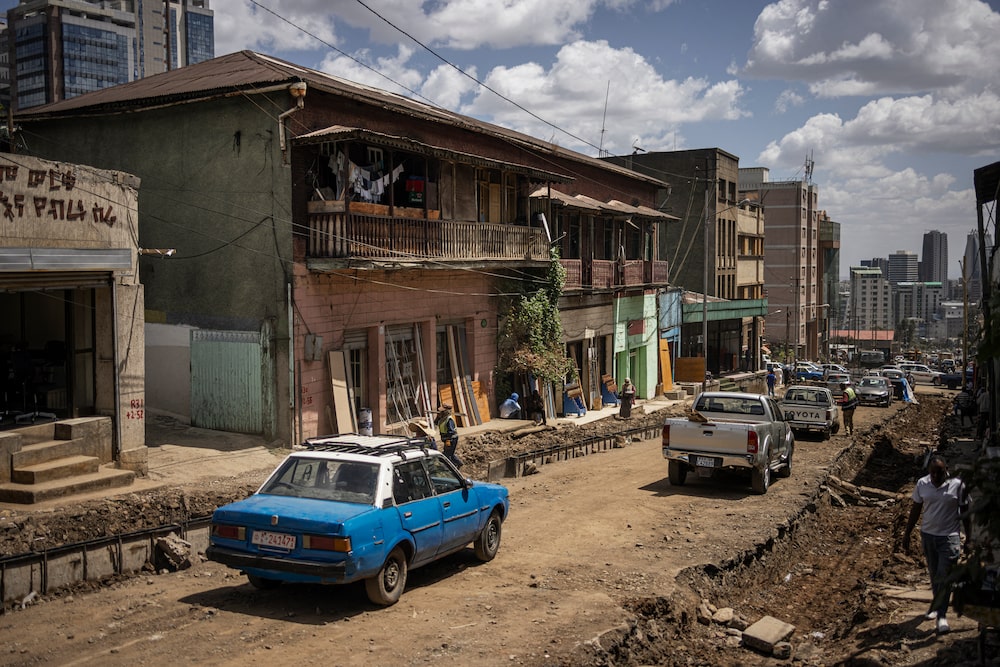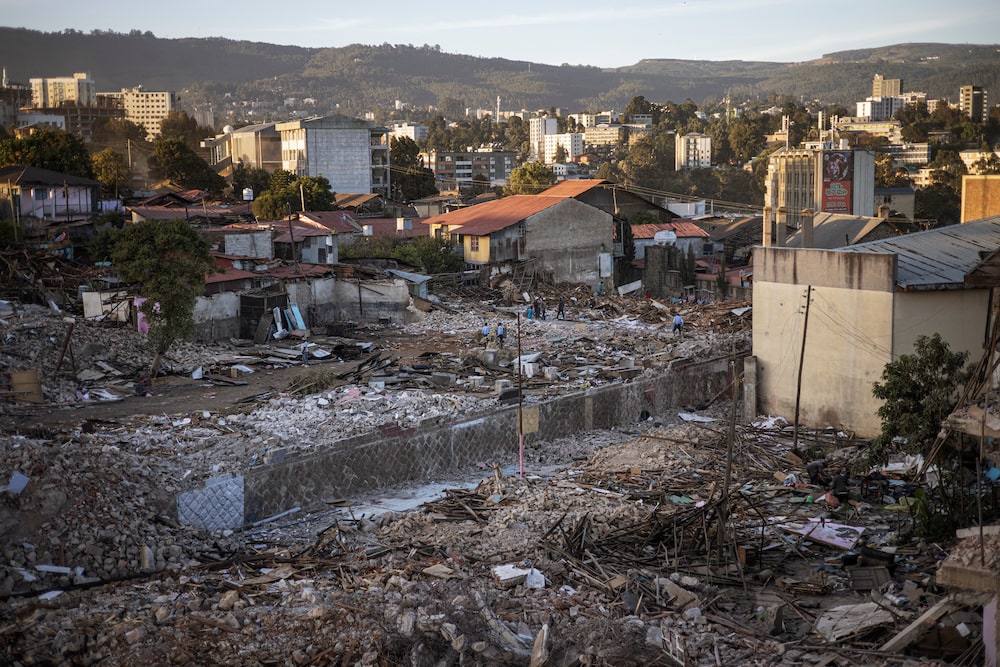
Weeks of demolition work have transformed the Piassa enclave of Addis Ababa, one of the targets of a government plan to build new real estate to attract foreign investment.Photography by Michele Spatari/AFP via Getty Images
A massive demolition campaign in the heart of Addis Ababa is sparking criticism from heritage experts who are mourning the loss of dozens of historic buildings in one of the city’s most famous neighbourhoods.
The radical overhaul of the Ethiopian capital is a key element in Prime Minister Abiy Ahmed’s ambitious drive to attract foreign investors by building modern skyscrapers, wide roads, museums, parks and bicycle paths. But in the process, he is destroying much of the city’s unique history, critics say.
As the site of the African Union headquarters and capital of one of Africa’s most populous countries, Addis Ababa is home to many foreign diplomats and businesses, making it one of the most strategically important cities on the continent. But the Prime Minister has made clear his distaste for the dirt and grime of its most densely populated districts.
His government has launched a Corridor Development program and a Clean Streets, Healthy Lives campaign to redesign the city of nearly six million people.
According to some experts, however, the heritage of Addis Ababa is being sacrificed in the modernization drive. And the government is still struggling to complete many of the skyscrapers and other projects it began building.

Nearly 2,000 of Piassa's buildings been demolished over the past few weeks.
The most sweeping wave of demolitions has targeted an old enclave known as Piassa, built around a marketplace more than 120 years ago and given an Italian name when it was further developed during the Italian occupation in the 1930s. For much of the past century, it has been the most cosmopolitan and vibrant area in the city, filled with small shops and cafés.
Nearly 2,000 buildings in Piassa have been demolished with bulldozers and sledgehammers in recent weeks. An estimated 11,000 people have been forced to leave their homes or businesses, often with little warning and no place to go. Today the neighbourhood is almost completely razed.
Much of the demolition is aimed at allowing roads to be widened – central to Mr. Abiy’s vision of a clean and orderly city. It has also made room for a huge new museum, the Adwa Victory Memorial Museum, which commemorates an Ethiopian military victory over Italian forces in 1896.
Many of the owners of demolished buildings are afraid to speak to the media, fearing retribution from the government. But so far, at least 56 buildings on the official heritage list in Piassa have been fully or partly destroyed in the urban redevelopment scheme, according to Ethiopian media reports.
“These buildings were repositories of the legacy of the capital’s past, intertwining different architectural traditions, including Armenian, Indian, Greek and Ethiopian influences, and a record of the Italian occupation period,” Eyob Derillo, a London-based scholar specializing in Ethiopian manuscripts and literature, said in an interview with The Globe and Mail.

People drink tej, an Ethiopian honey wine, at an old tej house in Piassa. Cafés and small shops have come to define this neighbourhood, which grew up around a marketplace after emperor Menelik II established Addis Ababa as the capital in the late 19th century.



Piassa is also home to the Adwa Victory Memorial Museum, commemorating the battle in 1896 where the armies of Menelik II drove back an Italian invasion force. Italy invaded again 40 years later, occupying the country for five years.
Most of the residents and entrepreneurs of Piassa – a mix of Ethiopians and the dwindling descendants of the Italian and Armenian businessmen who once occupied the elegant living quarters and shops – were issued eviction notices this year, often just a few days before bulldozers arrived.
“The scale of the ongoing demolition of heritage buildings, urban spaces and mistreatment of historical boulevards is unspeakable,” said Nahom Teklu, an architect in Addis Ababa. “The action of the government is a bold statement against the people’s right to the city,” he told The Globe. “What do you call this, if not gentrification or aggressively exclusive?”
Mr. Abiy has shown little sympathy for the historical preservation argument. “A randomly built mud house does not constitute a historical heritage,” he told the Ethiopian parliament recently.
At a public meeting, he said Addis Ababa needs to model itself after Dubai, the ultramodern city in the United Arab Emirates. “Infrastructure and aesthetics attract wealth,” he said. “They have magnetic power. Unless we change Addis Ababa, we cannot attract foreign resources. ... Unless we demolish with determination, we cannot build a country.”
Most of the bulldozed sites in Piassa are to be auctioned to the highest bidder. The government says it will soon introduce legislation to allow foreigners to own property here for the first time. Wealthy investors from the United Arab Emirates are believed to be among those the government is courting.
Among those whose homes were demolished, some were offered subsidized housing in suburban condominium towers or promised a small compensation payment or plots of land. But many have become destitute in a fast-changing city where the poor are being left behind.



Among the razed buildings is the magnificent former home of Alfred IIg, a Swiss engineer who became Ethiopia’s foreign minister for a decade during the era of Emperor Menelik in the late 19th century. He helped plan and build the railway line from Ethiopia to Djibouti, along with landmark buildings and bridges.
A wooden home once belonging to an Armenian architect, Minas Kherbekian, was not spared from demolition either. It was designated as a heritage site but had been neglected and left as an eyesore for years. Mr. Kherbekian had been instrumental in designing the Taitu Hotel, Ethiopia’s first modern hotel, which opened in 1907. It has since become another neglected building whose future is uncertain amidst the demolitions.
One of the first buildings to be torn down in the Piassa neighbourhood was the famed Lion Pharmacy, founded by German pharmacist Kurt Hildebrandt in 1950 during the era of Emperor Haile Selassie and run for decades by Mr. Hildebrandt’s son, Karl. The two-storey building, one of the first modern pharmacies in Addis Ababa, was abruptly flattened by the authorities last year, despite the city government’s promise to protect it as a historic site and attempts by German diplomats to save it.
With its old wooden floors and shelves, the pharmacy was a treasured landmark for many Ethiopians. An online petition tried to rally support for it. “Let’s come together to keep Lion Pharmacy, a well-loved establishment, as part of Piassa’s heritage,” it said.
Their appeals were ignored. The owners were given a few hours to evacuate their belongings in the middle of the night. Construction of a skyscraper began soon after.
With a report from Geoffrey York in Johannesburg.